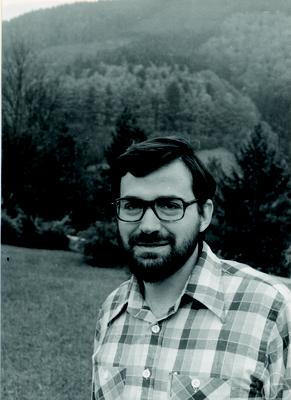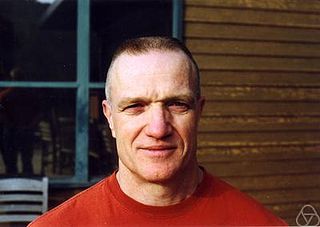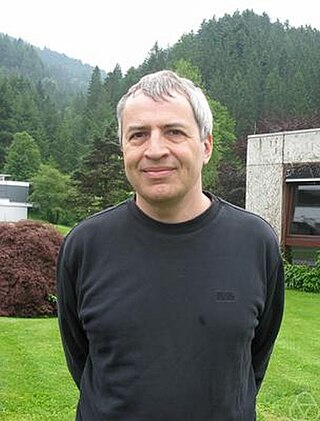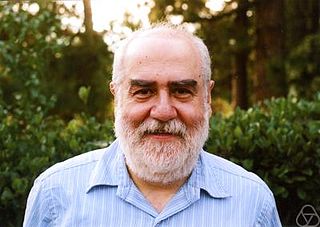Related Research Articles

Richard Melvin Schoen is an American mathematician known for his work in differential geometry and geometric analysis. He is best known for the resolution of the Yamabe problem in 1984.
In mathematical general relativity, the Penrose inequality, first conjectured by Sir Roger Penrose, estimates the mass of a spacetime in terms of the total area of its black holes and is a generalization of the positive mass theorem. The Riemannian Penrose inequality is an important special case. Specifically, if (M, g) is an asymptotically flat Riemannian 3-manifold with nonnegative scalar curvature and ADM mass m, and A is the area of the outermost minimal surface (possibly with multiple connected components), then the Riemannian Penrose inequality asserts
Frank Morgan is an American mathematician and the Webster Atwell '21 Professor of Mathematics, Emeritus, at Williams College. He is known for contributions to geometric measure theory, minimal surfaces, and differential geometry, including the resolution of the double bubble conjecture. He was vice-president of the American Mathematical Society and the Mathematical Association of America.

Leon Melvyn Simon, born in 1945, is a Leroy P. Steele Prize and Bôcher Prize-winning mathematician, known for deep contributions to the fields of geometric analysis, geometric measure theory, and partial differential equations. He is currently Professor Emeritus in the Mathematics Department at Stanford University.

George C. Papanicolaou is a Greek-American mathematician who specializes in applied and computational mathematics, partial differential equations, and stochastic processes. He is currently the Robert Grimmett Professor in Mathematics at Stanford University.

Robert Leamon Bryant is an American mathematician. He works at Duke University and specializes in differential geometry.

John William Lott is a professor of Mathematics at the University of California, Berkeley. He is known for contributions to differential geometry.

Gunther Alberto Uhlmann Arancibia is a mathematician whose research focuses on inverse problems and imaging, microlocal analysis, partial differential equations and invisibility.
Stephen William Semmes is the Noah Harding Professor of Mathematics at Rice University. He is known for contributions to analysis on metric spaces, as well as harmonic analysis, complex variables, partial differential equations, and differential geometry. He received his B.S. at the age of 18, a Ph.D. at 21 from Washington University in St. Louis and became a full professor at Rice at 25.
Paul Charles Rosenbloom was an American mathematician.

Claude R. LeBrun is an American mathematician who holds the position of Distinguished Professor of Mathematics at Stony Brook University. Much of his research concerns the Riemannian geometry of 4-manifolds, or related topics in complex and differential geometry.

Gerhard Huisken is a German mathematician whose research concerns differential geometry and partial differential equations. He is known for foundational contributions to the theory of the mean curvature flow, including Huisken's monotonicity formula, which is named after him. With Tom Ilmanen, he proved a version of the Riemannian Penrose inequality, which is a special case of the more general Penrose conjecture in general relativity.

Kenji Fukaya is a Japanese mathematician known for his work in symplectic geometry and Riemannian geometry. His many fundamental contributions to mathematics include the discovery of the Fukaya category. He is a permanent faculty member at the Simons Center for Geometry and Physics and a professor of mathematics at Stony Brook University.
Yongbin Ruan is a Chinese mathematician, specializing in algebraic geometry, differential geometry, and symplectic geometry with applications to string theory.

Sylvestre F. L. Gallot is a French mathematician, specializing in differential geometry. He is an emeritus professor at the Institut Fourier of the Université Grenoble Alpes, in the Geometry and Topology section.
David Allen Hoffman is an American mathematician whose research concerns differential geometry. He is an adjunct professor at Stanford University. In 1985, together with William Meeks, he proved that Costa's surface was embedded. He is a fellow of the American Mathematical Society since 2018, for "contributions to differential geometry, particularly minimal surface theory, and for pioneering the use of computer graphics as an aid to research." He was awarded the Chauvenet Prize in 1990 for his expository article "The Computer-Aided Discovery of New Embedded Minimal Surfaces". He obtained his Ph.D. from Stanford University in 1971 under the supervision of Robert Osserman.
Peter Wai-Kwong Li is an American mathematician whose research interests include differential geometry and partial differential equations, in particular geometric analysis. After undergraduate work at California State University, Fresno, he received his Ph.D. at University of California, Berkeley under Shiing-Shen Chern in 1979. Presently he is Professor Emeritus at University of California, Irvine, where he has been located since 1991.
Joel Spruck is a mathematician, J. J. Sylvester Professor of Mathematics at Johns Hopkins University, whose research concerns geometric analysis and elliptic partial differential equations. He obtained his PhD from Stanford University with the supervision of Robert S. Finn in 1971.
Rafe Roys Mazzeo is an American mathematician working in differential geometry, microlocal analysis, and partial differential equations. He is currently a professor of mathematics. He served as the department chair at Stanford University from 2007 to 2010 and 2019–2022.
Tom Ilmanen is an American mathematician specializing in differential geometry and the calculus of variations. He is a professor at ETH Zurich. He obtained his PhD in 1991 at the University of California, Berkeley with Lawrence Craig Evans as supervisor. Ilmanen and Gerhard Huisken used inverse mean curvature flow to prove the Riemannian Penrose conjecture, which is the fifteenth problem in Yau's list of open problems, and was resolved at the same time in greater generality by Hubert Bray using alternative methods.
References
- ↑ Ohashi, Seiju; Shiromizu, Tetsuya; Yamada, Sumio (2009-08-13). "Riemannian Penrose inequality and a virtual gravitational collapse". Physical Review D. 80 (4): 047501. arXiv: 0906.2042 . Bibcode:2009PhRvD..80d7501O. doi:10.1103/PhysRevD.80.047501. S2CID 55991838.
- ↑ "Fine-tuning Stephen Hawking's theory of mass" . Retrieved 2015-08-05.
- ↑ "The Mathematics Genealogy Project - Hubert Bray". www.genealogy.math.ndsu.nodak.edu. Retrieved 2015-08-05.
- ↑ ICM Plenary and Invited Speakers since 1897 Archived 2017-11-24 at the Wayback Machine (International Mathematical Union)
- ↑ List of Fellows of the American Mathematical Society
- ↑ "Hubert Bray | Scholars@Duke". Duke University. Retrieved 2019-10-31.
- ↑ Photographers, Stan Begam's The Bel-Air Co (1962). "Hubert Bray, Rice University". Rice University Archives General Photo Files, "Individuals - Bray, Hunert Evelyn," Woodson Research Center, Fondren Library, Rice University. hdl:1911/75752.
- ↑ "Clark Bray | Department of Mathematics". math.duke.edu. Retrieved 2019-10-31.
- ↑ Jones, Frank (2001). Lebesgue Integration on Euclidean Space. Jones & Bartlett Learning. ISBN 9780763717087.